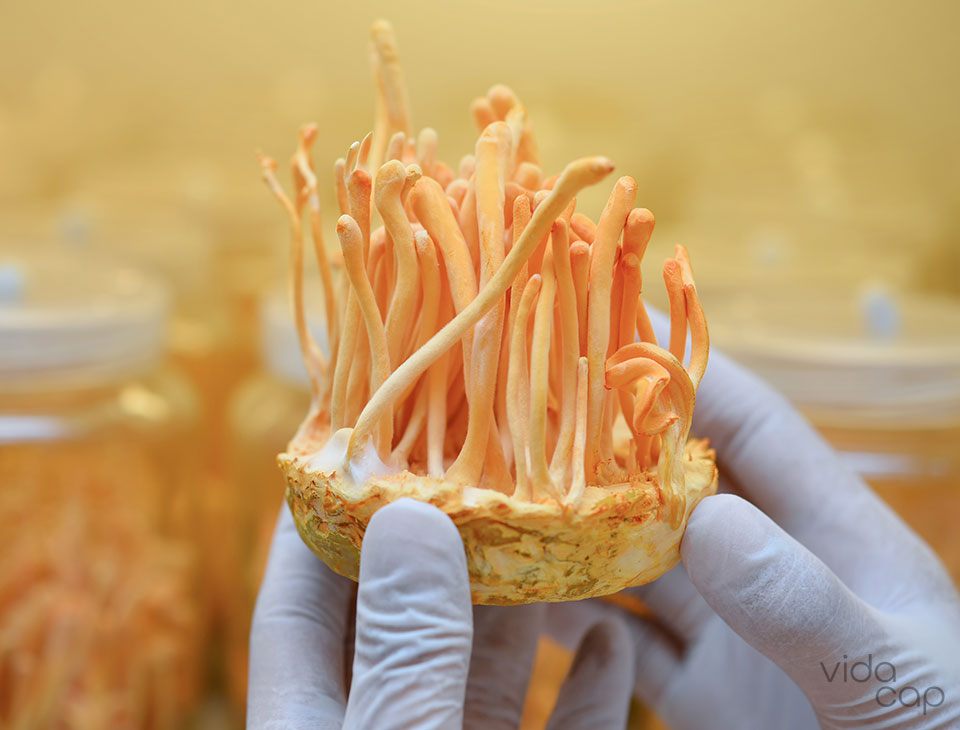
How to Dry Amanita Muscaria Mushrooms: VidaCap’s Guide
 Audrey Ferguson |
Updated on: September 26, 2023
Audrey Ferguson |
Updated on: September 26, 2023
Drying mushrooms is a crucial way to extend shelf life and retain potency. It is crucial for mushrooms like Amanita muscaria, where you are unlikely to use your entire supply at once.
There are several ways to dry Amanita muscaria, ranging from simple to complex. Read on to determine which is best for you.
Pre-Drying Amanita Muscaria Mushrooms
Pre-drying mushrooms helps to speed up the process significantly. It is as simple as spreading the mushrooms out on a towel or piece of cardboard for a few hours. Once the mushrooms become rubbery and their skin starts to wrinkle, you are ready to start the drying process itself.
When pre-drying, ensure the mushrooms are not touching and have enough space for air to circulate around them. Place them out of direct sunlight in an area with good ventilation. You can increase air circulation further by placing them in front of a fan.
Another way to speed up the process is by cutting the mushrooms into smaller pieces. But does this reduce potency? Let’s take a look.
Does Cutting Amanita Mushrooms Reduce Potency?
Because Amanita muscaria mushrooms are on the large side, they can take a long time to dry. Therefore, it can be helpful to cut them into smaller pieces to increase surface area and speed up the process.
Some may be concerned that cutting or tearing mushrooms could reduce their potency. Indeed, with psilocybin-containing magic mushrooms, this may be the case. When psilocybin comes into contact with air, a chemical reaction breaks it down, resulting in the blue coloration that some magic mushrooms display.

However, because Amanita muscaria mushrooms do not contain psilocybin, cutting them into smaller pieces before drying should not be an issue.
Separate the caps from the stems and cut them into evenly-sized pieces with a sharp knife. Be sure to cut through the thickest parts of the cap to ensure the mushrooms dry thoroughly in a minimal amount of time.
Don't want to go through the hassle of preparing your own Amanita muscaria?
At VidaCap, we've done the hard work for you. Our Amanita muscaria gummies are an already-prepared way to enjoy Amanita muscaria easily.
The Easiest Amanita Muscaria Drying Methods
The easiest ways to dry Amanita muscaria mushrooms include air drying, using a dehydrator, using an oven, and using a desiccant. Each method has pros and cons, as we will explain below.
Air Drying Amanita Muscaria Mushrooms
Air drying is the simplest method of drying Amanita muscaria mushrooms, as you need very little equipment. It is the most natural and traditional technique.
However, because it is slower than other drying methods, the mushrooms are more likely to go bad. If you live in a humid climate, you may be unable to air-dry Amanita muscaria successfully. However, if you live somewhere with low humidity, it may be worth a shot.
What You Need
- Wire racks
- Cardboard
- A fan (optional but recommended)
The Drying Process
Cover your wire racks with sheets of cardboard and spread the mushrooms in a single layer on top. Allow enough space between the mushrooms so that air can circulate freely.
Place the racks out of direct sunlight in an area with good ventilation. You can use a fan to increase airflow further if necessary.
Check the mushrooms regularly to ensure they are drying and not going bad. They should be cracker dry before storing them, meaning they snap easily between your fingers and do not bend.
If the mushrooms are not cracker dry after 48 hours, you may need to finish drying them using one of the methods below.
Drying Amanita Muscaria Mushrooms Using a Dehydrator
Using a dehydrator to dry mushrooms is extremely straightforward. The only real downsides are the initial expense of buying a dehydrator and the electricity you need to run it. However, you can pick up a dehydrator reasonably cheaply, and it is a worthwhile investment if you intend to dry mushrooms regularly.
Which Dehydrator to Use
There are many different dehydrators on the market, ranging from budget to professional models.
Even the cheapest dehydrators usually work fine. However, sometimes they have stackable racks with a fan at the bottom of the machine. This means you must switch the racks around at regular intervals to ensure the mushrooms dry evenly. To avoid this minor pitfall, look for a dehydrator with a fan at the back rather than the bottom.
Size is also a consideration. If you have a large quantity of Amanita muscaria to dry, a bigger dehydrator will allow you to fit in your whole supply while still leaving enough room for air to circulate.
The Drying Process
Place the mushrooms in a single layer on the shelves of the dehydrator, ensuring you leave enough space for air to circulate between them.
Set your dehydrator to 158 degrees Fahrenheit or 70 degrees Celcius. This temperature is considered optimal for drying Amanita muscaria as it helps to kickstart the decarboxylation process and convert some of the mushrooms’ ibotenic acid into muscimol.
Check the mushrooms regularly and remove them from the dehydrator when they are cracker dry. This may take several hours, depending on the size of the mushroom pieces and the dehydrator model.
Allow the mushrooms to cool before placing them in airtight glass jars for storage.
Drying Amanita Muscaria Mushrooms in an Oven
If you cannot access a dehydrator, a regular oven is a good alternative. Oven drying is faster than air drying and reduces the risk of the mushrooms going bad.
The main downside is the cost of running the oven for several hours. Moreover, you won’t be able to use it for cooking while drying the mushrooms, so plan accordingly!
What You Need
- Wire racks
- Wooden spoon
- Oven thermometer (optional but recommended)
The Drying Process
Spread the mushrooms in a single layer on the wire racks. Space them out so that air can circulate between them.
Heat the oven to 158 degrees Fahrenheit or 70 degrees Celcius. It is recommended to use an oven thermometer to check the temperature, as not all ovens are accurate.
Place the mushrooms in the oven and use the wooden spoon to wedge the oven door open a crack. This is essential as it allows air to circulate and ensures the mushrooms dry rather than cook.
Check the mushrooms regularly and remove them from the oven when they are cracker dry. This may take several hours.
Allow the mushrooms to cool before storing them in airtight glass jars.
Drying Amanita Muscaria Mushrooms Using a Desiccant
A desiccant is a substance that has a high affinity for water and helps to suck moisture out of the mushrooms. It may not be effective as a primary method for drying Amanita muscaria. However, it might help finish off mushrooms that have been air-dried and still retain some moisture.

The advantage is that it is low-tech and requires no energy use. The main disadvantage is that it might not work well on its own and is mainly useful in combination with other drying methods. You may also need to buy various items to complete this method successfully.
Even if you do not use a desiccant for drying your mushrooms, it can be helpful to add something such as food-grade silica gel packs to act as a desiccant when storing Amanita muscaria long term. This will help prevent the mushrooms from rehydrating and going bad.
What You Need
- A desiccant (see below)
- Airtight storage containers
- Mesh or wire racks
Which Desiccant to Use
There are a couple of different options when it comes to desiccants. The most common are silica (silica gel, beads, or cat litter, etc.), calcium sulfate (Drierite, plaster of Paris, gypsum, etc.), and calcium chloride (DampRid, etc.). Many people prefer silica-based desiccants, which are safe, cost-effective, and can often be regenerated in an oven or microwave.
Some desiccants come with an indicator that shows when it is spent. This is usually cobalt chloride, which turns from blue to pink when saturated with water. Cobalt is a heavy metal, so it is essential to prevent your mushrooms from coming into contact with the desiccant. This is good practice even if your desiccant does not contain an indicator.
The Drying Process
Spread the desiccant in an even layer on the bottom of your containers.
Arrange the mesh or wire racks above the desiccant so that the mushrooms will not come into direct contact with it.
Place the mushrooms on top of the mesh or wire racks, preferably in a single layer or packed as loosely as possible. Place the lids on the containers.
Check the mushrooms regularly and remove them from the containers for storage once they are cracker dry.
Storing Dried Amanita Muscaria Mushrooms
You can store dried Amanita muscaria mushrooms in airtight glass jars, out of direct sunlight, for several months. You may wish to place some food-grade silica gel packs in the jars to prevent rehydration.
The drying process significantly increases shelf life compared with fresh mushrooms. However, they can lose potency over time, so it is best to use them as soon as you can.
Another option is to use your mushrooms to make Amanita tea and store it in individual portions in a freezer. This method extends the mushrooms’ shelf life even further. Learn more about this technique and how to prepare Amanita muscaria for consumption here on the VidaCap blog.
-
new
 Amanita Muscaria Mushroom GummiesCalm | Mindfulness | Balance$38 Shop now
Amanita Muscaria Mushroom GummiesCalm | Mindfulness | Balance$38 Shop now- Experience a calming and balancing buzz effect.
- 8 Delicious Berry-Mango and Citrus gummies
- 500mg amanita extract per gummy for best results
- Proudly vegan and gluten-free
- Manufactured in the USA with high-quality standards

Audrey has worked as a registered dietitian for 6 years. She graduated from the University of Florida in 2013 with a Bachelor of Science degree. In 2014 she began an internship with the Veterans Affairs Healthcare System, and was hired as an Outpatient Dietitian following graduation. She started her career counseling a variety of patients with different health concerns and disease states. After a few years into practice, she found her passion was working in cancer care, and has spent the last 4 years specializing in oncology nutrition.
In her practice, Audrey has spent a significant amount of time reviewing literature on herbal and dietary supplements in the cancer care setting. Through her work at Vidacap, she hopes to continue to expand her knowledge and understanding of the benefits of supplements in conjunction with promoting a healthy, balanced diet and management of overall health and well being.
Lynn Marie Morski
Reviewed by Lynn Marie Morski, MD, JD, who is a president of the Psychedelic Medicine Association and host of the Psychedelic Medicine Podcast. She sits on the advisory boards of Psychedelics Today, Cybin, VETS, Inc (Veterans Exploring Treatment Solutions), the Oxenberg Foundation, and the Ketamine Task Force.
Read More

 by Lynn Marie Morski, MD
by Lynn Marie Morski, MD




